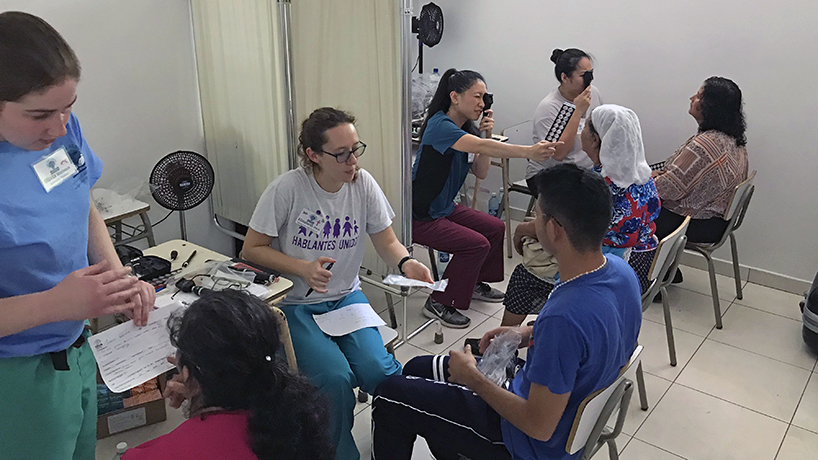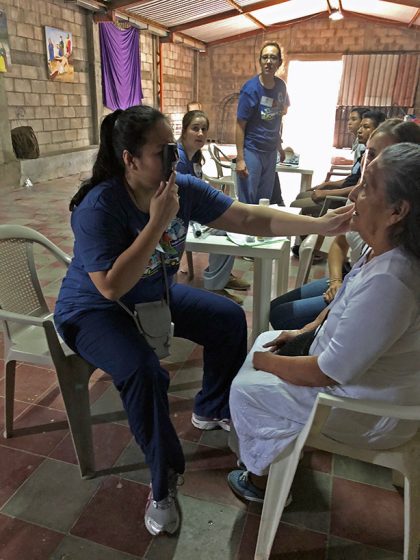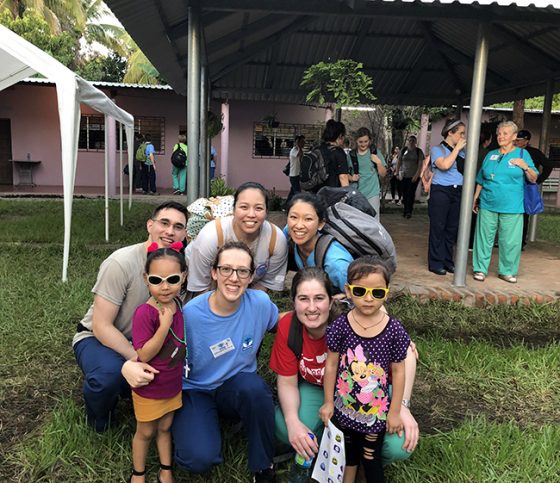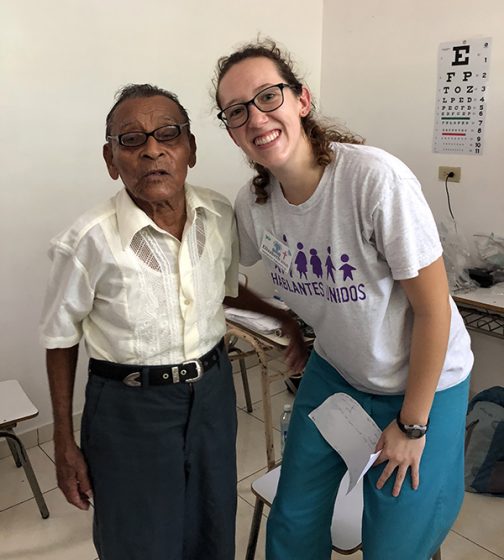
In November, a group from the College of Optometry, including (back row, from left) third-years Olivia Hoylman and Elizabeth Ditch, Assistant Clinical Professor Linda Nguyen and fourth-year Marie Lulette Fermil, joined a Helping Hands Medical Missions trip to El Salvador. (Photo courtesy of Linda Nguyen)
As the bus pulled up to the first community on the first day in an eight-day medical mission trip to El Salvador, Marie Lulette Fermil looked out her window and thought, “Oh, dang, that’s a lot of people that I’m going to see.”
The University of Missouri–St. Louis optometry student stepped off to applause and singing.
Overwhelmed, she burst into tears.
“I did not expect how big of a deal it was for them,” she said. “It was like a fiesta. They had little kids singing and performing for us. I was like, ‘Oh my gosh, I’m going to not meet their expectations, and I’m not going to be able to help all of them.’ But they were really appreciative of everything, and it was such a good experience.”
Fermil joined classmates Elizabeth Ditch and Olivia Hoylman and Assistant Clinical Professor Linda Nguyen in Santiago Texacuangos, El Salvador, from Nov. 2-10 on a Helping Hands Medical Missions trip led by Dr. Peter Danis of Mercy Hospital St. Louis. Although Helping Hands has been visiting Santiago Texacuangos since 1999, the 2018 trip was the first for representatives of the College of Optometry.

Marie Lulette Fermil (foreground) checks her patient’s vision while Olivia Hoylman (center) and Elizabeth Ditch (right) look on. (Photo courtesy of Marie Lulette Fermil)
It was also a first for Helping Hands – never before had the trip included eye care. The UMSL team joined a group of providers whose specialties included primary care, nursing and surgery as well as nonmedical volunteers such as translators and Catholic missionaries. Collectively, the group served more than 4,000 individuals in the four communities they visited with the optometry team seeing approximately 800 patients.
“I was so grateful that they were able to be with us this year and help so many people, and I really look forward to building on that,” Danis said. “It’s such a great experience for the students, a learning experience outside of the classroom, and it’s really priceless, and that’s something that I know Linda would echo as well. I really look forward to continuing to work with the UMSL College of Optometry and their fine people there.”
Danis contacted the school looking for a partner and found one in Nguyen, who started recruiting students after attending a Helping Hands fundraiser in April.
Fermil – a F. Edward Hébert Armed Forces Health Professions Scholarship Program recipient who’d served in the Army as an optical technician – had long wanted to go on a medical mission trip. The fourth-year student signed up soon after third-years Hoylman and Ditch, who had interpreted on two Helping Hands trips previously. The group was joined by Ditch’s mother, a nurse, and Fermil’s husband, a native Spanish speaker.
Nguyen and the students began planning by thinking about what would be realistic to bring along and what types of eye problems and diseases – such as growths on the clear part of the eye known as pterygium and cataracts – they were likely to see.
“We thought about what can we help out with because we don’t have the big equipment to bring like some other mission trips,” Fermil said. “We decided glasses; it’s like an instant difference for them because you put them on and you can see.”
They also packed artificial tears, antibiotic drops and hypotensive drops to bring down eye pressure for glaucoma control, as well as sunglasses and hats to protect against UV damage.
“Dr. Nguyen did a great job preparing for the mission,” Ditch said. “This was her first time, and she didn’t know what to expect. With her personal money, she went out and bought 3,000 pairs of glasses, and she reached out to companies to donate drops and reading glasses in all different powers.”
Even with all that inventory, there were times they encountered patients who needed unique prescriptions and they couldn’t provide them with exactly what they needed.
One patient, a diabetic woman with a prescription of -1 in one eye and -4 in the other, illustrated this conundrum. The students put their heads together and decided to put her in a pair of adjustable glasses that could be focused between -1 to -5 by turning a wheel on each side of the frames.
“They are perfect for diabetics because, based on your sugar level, your eye swells,” Ditch said. “Your lens swells with the sugar, so it could change your prescription, and she could change the wheel a little bit every day to get it just right.”

Third-year students (front row) Elizabeth Ditch and Olivia Hoylman, fourth-year student (back row, center) Marie Lulette Fermil, Assistant Professor Linda Nguyen (back right) and Fermil’s husband Fabien Cortez (back left) helped treat roughly 800 patients, including these two young girls. (Photo courtesy of Linda Nguyen)
Because of limited time and difficult conditions, the group decided to dilate the eyes of those most likely to have back-of-the-eye diseases, like Ditch’s diabetic patient.
“Her retinas looked really good, no problems back there, and I asked her if she exercised every day and took care of her health,” Ditch said. “She proudly stated, ‘Yes, I do a half an hour of walking every day,’ and I told her, ‘That’s really working well for you. Keep it up because your retinas, your eyes, are looking really good.’ She was ecstatic to hear that her work was paying off for her health, and she gave me a hug.
“She told me, ‘I’m going to bring my daughter in,’ and the next thing you know, her daughter’s in Olivia’s chair to be her patient, and then the next day we went back to the same community and grandma came in, her mom. So, three people from the same family all got eye exams, and that was pretty cool.”
The students were moved by the efforts the people of Santiago Texacuangos made to receive care. Many had vision problems from eye trauma, such as a childhood fall that resulted in a blind eye that had begun to atrophy. In that case, Ditch prescribed drops for pain and to reduce pressure, knowing that eventually that it would have to be removed. In another, a man blind from untreated glaucoma cried as Fermil explained that there was nothing that could be done. But afterward, he thanked the student for explaining the underlying condition.
While treating a cataract-blinded elderly man who had walked hours with a cane to reach the eye doctors, Hoylman thought, “How did he make it here?” She also helped a young girl with an eye turn – a condition that Hoylman shares.
“Here in the States, it probably would have been identified when she was less than 6 when we still could have done patching or surgery to fix it,” Hoylman said. “Glasses will help both eyes see equally so potentially she could start to use that eye more.”
Knowing the comparative ease of treatment in the U.S. was frustrating for the group. There were those odd prescriptions as well as the lack of larger equipment to adequately see into the back of the eye and few ophthalmologists for referrals.

Elizabeth Ditch (right) stands with a patient she fitted with glasses. (Photo courtesy of Linda Nguyen)
“There we had such limited resources that to have surgery, they have to be literally blind, not even reacting to any stimulus, so I think we only ended up referring three people,” Hoylman said. “That part was humbling, as was how grateful they were for reading glasses just to read their bibles.”
There were other difficulties associated with the makeshift exam spaces, and tropical temperatures meant the students were constantly sweating. But their hosts, more-well-off families that took turns providing safe and delicious food with “cakes galore” at every meal, worked hard to make sure the group was cared for and healthy. Overall, the trip was rewarding but tough.
“It was almost as exhausting as military basic training camp,” Fermil said with a laugh. “It was almost there, but not quite.”
In those eight days, Fermil treated more people than she had rotating through externship sites throughout the year. They all learned flexibility in making things work.
“In class, they learn how to treat and manage, but on the mission trip, they learned how to be resourceful,” Nguyen said. “Some of the standout moments were seeing the students on the first day of the mission, and then, certainly, by the end of the trip, they were acting very independently and asking the right questions and continuing to be firm in their care.”
All are planning future mission trips, and Ditch and Hoylman are already signed up to go to the Dominican Republic with Student Volunteer Optometric Services to Humanity. Aside from a renewed appreciation for the abundant resources in the United States, the group felt the experience made them better people and caregivers. Plus, meeting the people of El Salvador was invaluable.
“It was so cool to see their immediate responses to glasses,” Ditch said. “We could see their faces light up right away when their worlds instantly became clear, so that was pretty unique.”
Hoylman added, “We could tell even without speaking Spanish.”
Fermil agreed.
“We got all the hugs,” she said, “all the tears.”














